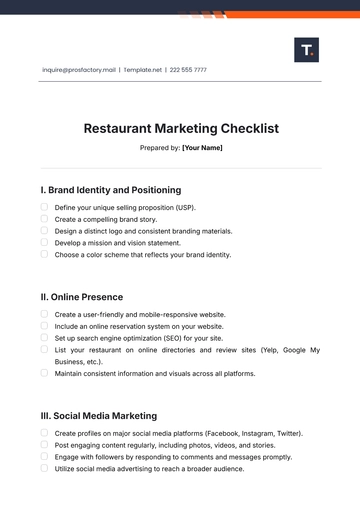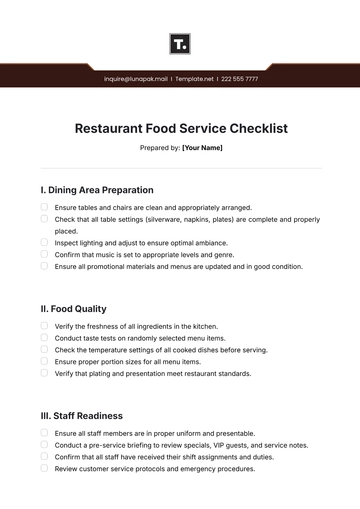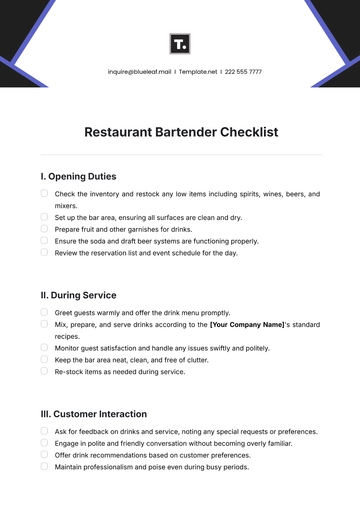Free Restaurant Planning Checklist

Embarking on the journey of opening a restaurant is an exciting endeavor that requires meticulous planning and attention to detail. This checklist serves as a comprehensive guide to ensure that every aspect, from concept development to post-opening evaluation, is carefully considered and executed to create a successful dining establishment under the banner of [Your Company Name].
Concept Development
Define the restaurant theme and dining experience
Determine the target audience
Research and choose a suitable location
Create a unique selling proposition (USP)
Develop a preliminary menu
Business Planning
Write a comprehensive business plan
Secure financing through loans or investors
Establish a business structure and legal entity
Register the business and obtain a tax identification number
Acquire necessary permits and licenses
Location and Build-Out
Finalize lease agreements or purchase property
Plan restaurant layout with an architect or designer
Complete renovation and decorating according to theme
Acquire necessary equipment and furniture
Setup utilities and services (water, gas, electricity, internet)
Operations Planning
Develop operations manuals and standard operating procedures
Choose and implement a POS system
Plan for inventory management systems
Establish vendor relations and supply chain
Create staff training programs and manuals
Marketing and Launch
Develop a pre-opening marketing plan
Create a website and social media profiles
Organize a soft opening or trial run
Plan grand opening event
Implement ongoing promotional strategies
Additional Reminders
Regularly review and update the business plan to reflect changes in the market or operating conditions.
Keep detailed records of all contracts, permits, and legal documents.
Maintain a consistent brand image across all customer touchpoints.
Always prioritize customer service to enhance customer loyalty.
Continually assess and adjust marketing strategies based on performance data and customer feedback.
- 100% Customizable, free editor
- Access 1 Million+ Templates, photo’s & graphics
- Download or share as a template
- Click and replace photos, graphics, text, backgrounds
- Resize, crop, AI write & more
- Access advanced editor
Stay organized with Template.net's Restaurant Planning Checklist Template. Editable in our AI Editor Tool, this customizable template ensures thoroughness and efficiency in your planning process. Crafted for simplicity and effectiveness, it streamlines your restaurant setup, covering tasks from concept development to launch. Simplify your planning with this essential resource from Template.net.
You may also like
- Cleaning Checklist
- Daily Checklist
- Travel Checklist
- Self Care Checklist
- Risk Assessment Checklist
- Onboarding Checklist
- Quality Checklist
- Compliance Checklist
- Audit Checklist
- Registry Checklist
- HR Checklist
- Restaurant Checklist
- Checklist Layout
- Creative Checklist
- Sales Checklist
- Construction Checklist
- Task Checklist
- Professional Checklist
- Hotel Checklist
- Employee Checklist
- Moving Checklist
- Marketing Checklist
- Accounting Checklist
- Camping Checklist
- Packing Checklist
- Real Estate Checklist
- Cleaning Checklist Service
- New Employee Checklist
- Food Checklist
- Home Inspection Checklist
- Advertising Checklist
- Event Checklist
- SEO Checklist
- Assessment Checklist
- Inspection Checklist
- Baby Registry Checklist
- Induction Checklist
- Employee Training Checklist
- Medical Checklist
- Safety Checklist
- Site Checklist
- Job Checklist
- Service Checklist
- Nanny Checklist
- Building Checklist
- Work Checklist
- Office Checklist
- Training Checklist
- Website Checklist
- IT and Software Checklist
- Performance Checklist
- Project Checklist
- Startup Checklist
- Education Checklist
- Home Checklist
- School Checklist
- Maintenance Checklist
- Planning Checklist
- Manager Checklist
- Wedding Checklist
- Vehicle Checklist
- Travel Agency Checklist
- Vehicle Inspection Checklist
- Interior Design Checklist
- Backpacking Checklist
- Business Checklist
- Legal Checklist
- Nursing Home Checklist
- Weekly Checklist
- Recruitment Checklist
- Salon Checklist
- Baby Checklist
- Equipment Checklist
- Trade Show Checklist
- Party Checklist
- Hospital Bag Checklist
- Evaluation Checklist
- Agency Checklist
- First Apartment Checklist
- Hiring Checklist
- Opening Checklist
- Small Business Checklist
- Rental Checklist
- College Dorm Checklist
- New Puppy Checklist
- University Checklist
- Building Maintenance Checklist
- Work From Home Checklist
- Student Checklist
- Application Checklist





























